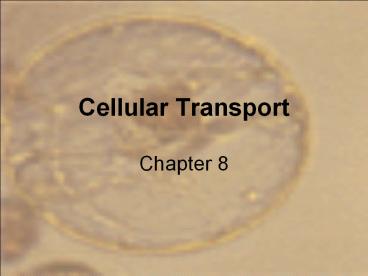Cellular Transport Chapter 8 - PowerPoint PPT Presentation
1 / 57
Title:
Cellular Transport Chapter 8
Description:
Cellular Transport Chapter 8 The detailed structure of an animal cell s plasma membrane The fluidity of membranes Some functions of membrane proteins Cells move ... – PowerPoint PPT presentation
Number of Views:116
Avg rating:3.0/5.0
Title: Cellular Transport Chapter 8
1
Cellular TransportChapter 8
2
The detailed structure of an animal cells plasma
membrane
3
The fluidity of membranes
4
Some functions of membrane proteins
5
Cells move substances through the cell membrane
by a process called transport
- Two Types of Transport
- Passive Transport
- Active Transport
6
What is Diffusion or Passive Transport?
- Requires no energy from cell.
- Molecules move from
- high concentration to
- low concentration.
- Molecules move with the
- concentration gradient.
7
The diffusion of solutes across membranes
8
Whats happening?
9
How would diffusion happen in a cell?
10
How would diffusion happen in a cell?
11
How would diffusion happen in a cell?
12
How would diffusion happen in a cell?
13
How would diffusion happen in a cell?
14
How would diffusion happen in a cell?
15
How would diffusion happen in a cell?
16
How would diffusion happen in a cell?
17
Osmosis is a type of diffusion
Cell Membrane
18
Osmosis is a type of diffusion
Cell Membrane
19
Osmosis is a type of diffusion
Cell Membrane
20
Osmosis is a type of diffusion
Cell Membrane
21
Osmosis is a type of diffusion
Cell Membrane
22
Osmosis is a type of diffusion
Cell Membrane
23
Osmosis is a type of diffusion
Cell Membrane
24
Osmosis is a type of diffusion
Cell Membrane
25
Osmosis
26
HELP WANTED!
- Facilitated Diffusion
- tranport proteins help substances (glucose) pass
through the cell membrane. Still passive
transport - no energy required.
27
HELP WANTED!
28
HELP WANTED!
29
HELP WANTED!
30
HELP WANTED!
31
HELP WANTED!
32
HELP WANTED!
33
HELP WANTED!
34
HELP WANTED!
35
HELP WANTED!
36
Two models for facilitated diffusion
37
Water balance of cells without walls
38
Which way did the water move?
Why did the cell get so big?
39
Which way did the water move?
Why did the cell stay the same size?
40
Which way did the water move?
Why did the cell get so small?
41
The water balance of living cells
42
The contractile vacuole of Paramecium an
evolutionary adaptation for osmoregulation
43
REVIEW
- What part of the cell regulates what goes in and
out? - What are the two components of the cell membrane?
- What are the two types of transport?
- What are the characteristics of passive transport?
44
MORE REVIEW
- Explain diffusion. Why does it occur?
- Explain osmosis. Why does it occur?
- Explain facilitated diffusion.
- What is the role of the transport protein in
facilitated diffusion?
45
Even MORE Review!
- What happens to an animal cell when there are
more dissolved substances on the outside of the
cell? - The inside?
- When there are equal amounts?
46
How is Active Transport different?
- Active transport requires energy.
- Molecules move from low concentration to high
concentration - Molecules move against concentration gradient.
47
Review passive and active transport compared
48
The sodium-potassium pumpActive Transport
49
An electrogenic pump
50
Cotransport
51
Endocytosis
- Cells bring in large particles using cell
membrane - There are 2 types
- Phagocytosis
- Pinocytosis
52
Phagocytosis
Amoeba
- This is the ingestion of large particles.
- Your white bloods cells also do this.
53
Pinocytosis
- Tiny pockets form along cell membrane, and pinch
off into vacuoles inside the cell. Sometimes
called Cell Drinking
54
Exocytosis
- This is how the cell gets rid of waste.
55
The three types of endocytosis in animal cells
56
REVIEW
- How is Active transport different from passive?
- What part of the cell is used to bring in
particles? - How does a cell (including white blood cells)
take in LARGE particles? - How does a cell take in small or liquid
particles?
57
ESSAY
- Describe the fluid-mosaic model of a plasma
membrane. - Discuss the role of the membrane in the movement
of materials through by each of the following
processes. - Active Transport
- Passive Transport































